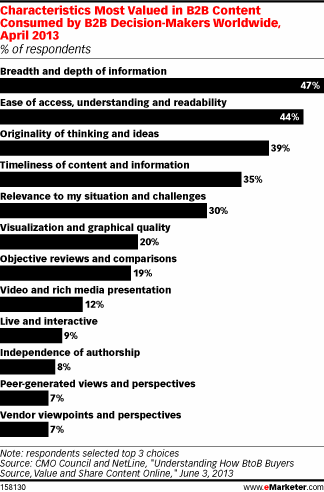New B2B Content Consumption Habits In An Ever-Changing Advertising Funnel
In my last article, I discussed how some marketing tactics and concepts of yesteryear can still be applied in advertising to B2B customers today. Inevitably, however, some marketing media and channels have changed. The world of advertising has shifted from a one-step advertising funnel to a multi-step funnel, caused simply by the inception of the […]
In my last article, I discussed how some marketing tactics and concepts of yesteryear can still be applied in advertising to B2B customers today.
Inevitably, however, some marketing media and channels have changed. The world of advertising has shifted from a one-step advertising funnel to a multi-step funnel, caused simply by the inception of the Internet and the ability it’s given people to easily access content.
Knowing that, we’ll investigate how B2B content consumption habits have changed and discuss how to leverage these new habits for a successful PPC advertising campaign.
Content Rift #1: Trade Print Content Is Out, Online Content Is In
Growing up, my father had a home office. What I remember best about this office (besides using his work computer to play King’s Quest) are the piles and stacks of mail he had everywhere — catalogs, prospectuses, statements, newspapers and industry magazines. I remember my father avidly reading this content throughout the day, from breakfast to dinner.

Image via Shutterstock
Flash forward to today. When I head to my local IT department, there the same piles of the same content sit…untouched and unconsumed.
If an equity trading company wants to check quotes or research stock, they’ll go to the Internet to find this information. If a shipping company wants to find information about a particular passage and rates, they’ll go online to find this info. If an IT Decision Maker (ITDM) wants to read information about new equipment, they find trade blogs that peers write to understand if it’s a good fit for their company.
The top of the funnel — the preliminary research stage before starting a relationship or making a sale — is now more accessible thanks to the Internet, and B2B advertisers need to make sure they are present from the start of this research. This means having a content presence and ensuring that your ads serve next to content that your targeted audience is consuming — be it on Google’s Display Network or other content networks (Vibrant, Kontera, etc.).
I’ve seen the most success in a B2B content strategy when ads are placed beside content that is relevant to your solution or product. I’ve also experimented with placing ads near content that the target customer is interested in based on demographic information (PGA tour, luxury travel, etc.) but seen much less success.
From my experience, the top of the funnel for us in PPC is still content-based, but the customer needs to at least be in the work (rather than personal) mindset for the advertising to have value and assist in conversion later.
Content Rift #2: B2Bs Use Online Video To Fuel Purchasing Decisions
B2B customers utilize video content much differently than a B2C consumer, and it’s important to understand these differences as producing professional content is resource-intensive and can potentially lead to a gap in your marketing strategy if not done correctly.
B2C consumers want video content that showcases features and demos the product, and they’re also seeking professional reviews/customer testimonials.
From my experience (backed up by recent eMarketer research), B2B customers want different information. They don’t want a sales pitch. They want to see the product in action — in a situation that they’re familiar with and need a solution for.
Potential B2B customers want to understand, in depth, what your hardware or solution can do for them. They also want to be able to access instructions on how to set up the product or troubleshoot potential issues. With readable content creating the awareness at the top of your marketing funnel, video content should now be integrated into your plan to fuel the consideration stage.
For example, one thing I’ve observed is that IT Decision Makers at small, medium and large companies need (and, in fact, are requesting) video content that speaks to them. How do I set up my server for the first time? How do I install this complex, multi-office network? How do I install this UPS in my rack? Are there any testimonials that showcase the excellent work your company has done, and the strong relationship it’s built with its customers?
While I used ITDMs as my example, it’s easy to see how this type of content might apply to other B2B industries as well. If no such content exists as part of your current marketing strategy, it may be worthwhile to begin developing this content to stay within (or above!) your competitive set — and to stay within the potential customer’s consideration set.
Content Rift #3: Product Listing Ads Are The New Price Sheet Or Catalog
While the past two rifts are applicable to a lead-gen or e-commerce paid search campaign, product listing ads (PLAs) are specifically meant for e-commerce. The beauty of PLAs is that they provide an e-commerce B2B customer with something new — a gauge of interest.

Image via Shutterstock
Placing product listing ads results in much higher conversion rates than casting a wide “net” (catalog) to potential customers. In my last article, I wrote that pricing is king, and this concept applies more than ever with the ability to do custom research and price shop to an extreme. Can you blame these businesses, though? Saving $5 per product on a bulk order could result in millions saved on the bottom-line budget!
If you are running a B2B e-commerce campaign and product listing ads are not part of the PPC portfolio, be sure to start incorporating them ASAP.
First, contact your Google representative to get whitelisted to run product listing ads. Obtain a feed of products sold on your site (from an inventory management system), format to the Google Merchant Center guidelines, and upload. Check pricing and competition on the search engine results page, create your campaigns and ads, and launch.
For one of my clients, product listing ads have a 25% higher conversion rate than a standard text ad. Watch your campaign take off and scale with product listing ads.
Final Thoughts
It is essential to adapt to B2B customers’ changing content consumption habits, as old media phase out and new media are introduced. This is achieved by building awareness next to relevant content, utilizing video as a research and consideration vehicle and closing the sale with product listing ads.
Opinions expressed in this article are those of the guest author and not necessarily Search Engine Land. Staff authors are listed here.
Related stories
